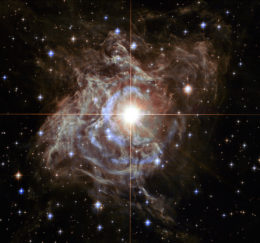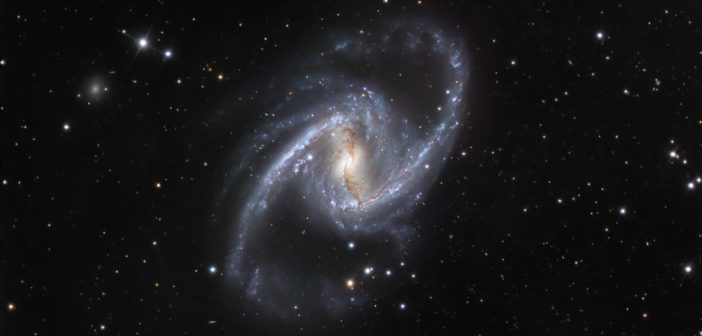Astronomers recently released details of the first Cepheid variable stars observed with JWST. These unique objects are used as cosmic rulers and so the new measurements have important consequences for our understanding of the universe’s expansion.
A Rung in the Cosmic Distance Ladder

Cepheid variable RS Puppis, pictured here in an image from the Hubble Space Telescope, is 15,000 times brighter than the Sun. Cepheids provide a way to measure the distances to other galaxies. [NASA, ESA, and the Hubble Heritage Team (STScI/AURA)–Hubble/Europe Collaboration; Acknowledgment: H. Bond (STScI and Pennsylvania State University)]
However, calculating those distances has always required some assumptions. Cepheids are often found in regions of recent star formation, so they are embedded in a lot of dust. Pushing Hubble observations into the near infrared helped to mitigate the effect of the dust, but had the knock-on effect of reducing Hubble’s resolution by a factor of two to three. In turn, this limited the precision with which astronomers could measure the brightness of the Cepheids.
JWST Enters the Scene
JWST represents a big upgrade. It has a greater resolution to start with and is specifically designed to work in the infrared. Astronomers plan to revisit all the Cepheids observed by Hubble. This will take years, but a team led by Wenlong Yuan (Johns Hopkins University) has released the preliminary results of an observation run taking in 31 Cepheids in the galaxy NGC 1365.

Apparent magnitude of Cepheid variable stars as a function of their period. JWST observations are shown in red and Hubble Space Telescope observations, translated to the same frequency as the JWST data, are shown in grey. Click to enlarge. [Yuan et al. 2022]
That said, the authors note the preliminary nature of these observations and that they are “far from the best JWST can do.” Future observations will have a longer exposure time and will benefit from improved calibration data. Only then will we truly know whether Cepheids are the key to unlocking the enigma of the Hubble tension.
Citation
“A First Look at Cepheids in a Type Ia Supernova Host with JWST,” Wenlong Yuan et al 2022 ApJL 940 L17. doi:10.3847/2041-8213/ac9b27
